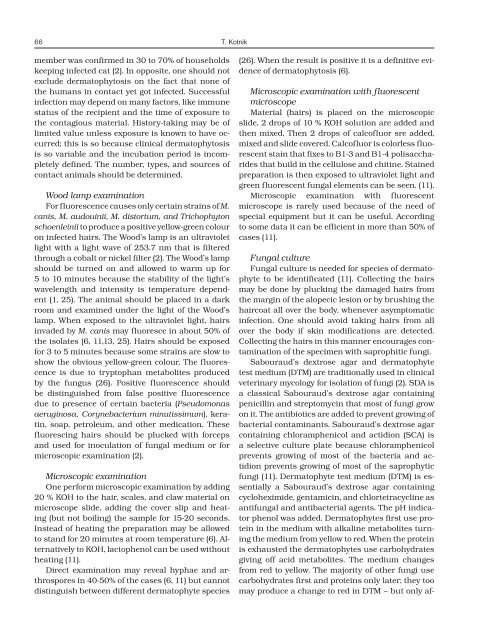SLOVENIAN VETERINARY RESEARCH
SLOVENIAN VETERINARY RESEARCH
SLOVENIAN VETERINARY RESEARCH
Create successful ePaper yourself
Turn your PDF publications into a flip-book with our unique Google optimized e-Paper software.
66T. Kotnikmember was confirmed in 30 to 70% of householdskeeping infected cat (2). In opposite, one should notexclude dermatophytosis on the fact that none ofthe humans in contact yet got infected. Successfulinfection may depend on many factors, like immunestatus of the recipient and the time of exposure tothe contagious material. History-taking may be oflimited value unless exposure is known to have occurred;this is so because clinical dermatophytosisis so variable and the incubation period is incompletelydefined. The number, types, and sources ofcontact animals should be determined.Wood lamp examinationFor fluorescence causes only certain strains of M.canis, M. audouinii, M. distortum, and Trichophytonschoenleinii to produce a positive yellow-green colouron infected hairs. The Wood’s lamp is an ultravioletlight with a light wave of 253.7 nm that is filteredthrough a cobalt or nickel filter (2). The Wood’s lampshould be turned on and allowed to warm up for5 to 10 minutes because the stability of the light’swavelength and intensity is temperature dependent(1, 25). The animal should be placed in a darkroom and examined under the light of the Wood’slamp. When exposed to the ultraviolet light, hairsinvaded by M. canis may fluoresce in about 50% ofthe isolates (6, 11,13, 25). Hairs should be exposedfor 3 to 5 minutes because some strains are slow toshow the obvious yellow-green colour. The fluorescenceis due to tryptophan metabolites producedby the fungus (26). Positive fluorescence shouldbe distinguished from false positive fluorescencedue to presence of certain bacteria (Pseudomonasaeruginosa, Corynebacterium minutissimum), keratin,soap, petroleum, and other medication. Thesefluorescing hairs should be plucked with forcepsand used for inoculation of fungal medium or formicroscopic examination (2).Microscopic examinationOne perform microscopic examination by adding20 % KOH to the hair, scales, and claw material onmicroscope slide, adding the cover slip and heating(but not boiling) the sample for 15-20 seconds.Instead of heating the preparation may be allowedto stand for 20 minutes at room temperature (6). Alternativelyto KOH, lactophenol can be used withoutheating (11).Direct examination may reveal hyphae and arthrosporesin 40-50% of the cases (6, 11) but cannotdistinguish between different dermatophyte species(26). When the result is positive it is a definitive evidenceof dermatophytosis (6).Microscopic examination with fluorescentmicroscopeMaterial (hairs) is placed on the microscopicslide, 2 drops of 10 % KOH solution are added andthen mixed. Then 2 drops of calcofluor sre added,mixed and slide covered. Calcofluor is colorless fluorescentstain that fixes to B1-3 and B1-4 polisaccharidesthat build in the cellulose and chitine. Stainedpreparation is then exposed to ultraviolet light andgreen fluorescent fungal elements can be seen. (11).Microscopic examination with fluorescentmicroscope is rarely used because of the need ofspecial equipment but it can be useful. Accordingto some data it can be efficient in more than 50% ofcases (11).Fungal cultureFungal culture is needed for species of dermatophyteto be identificated (11). Collecting the hairsmay be done by plucking the damaged hairs fromthe margin of the alopecic lesion or by brushing thehaircoat all over the body, whenever asymptomaticinfection. One should avoid taking hairs from allover the body if skin modifications are detected.Collecting the hairs in this manner encourages contaminationof the specimen with saprophitic fungi.Sabouraud’s dextrose agar and dermatophytetest medium (DTM) are traditionally used in clinicalveterinary mycology for isolation of fungi (2). SDA isa classical Sabouraud’s dextrose agar containingpenicillin and streptomycin that most of fungi growon it. The antibiotics are added to prevent growing ofbacterial contaminants. Sabouraud’s dextrose agarcontaining chloramphenicol and actidion (SCA) isa selective culture plate because chloramphenicolprevents growing of most of the bacteria and actidionprevents growing of most of the saprophyticfungi (11). Dermatophyte test medium (DTM) is essentiallya Sabouraud’s dextrose agar containingcycloheximide, gentamicin, and chlortetracycline asantifungal and antibacterial agents. The pH indicatorphenol was added. Dermatophytes first use proteinin the medium with alkaline metabolites turningthe medium from yellow to red. When the proteinis exhausted the dermatophytes use carbohydratesgiving off acid metabolites. The medium changesfrom red to yellow. The majority of other fungi usecarbohydrates first and proteins only later; they toomay produce a change to red in DTM – but only af-
















